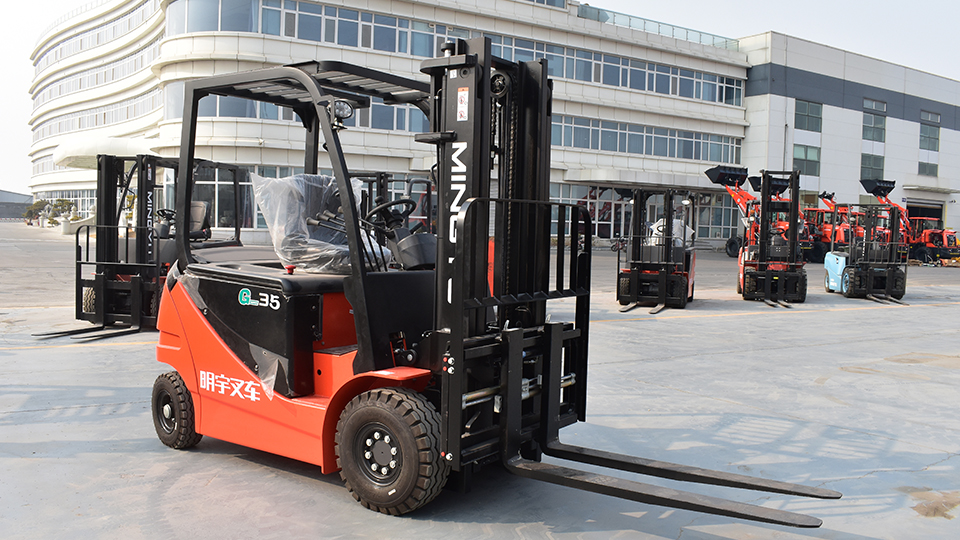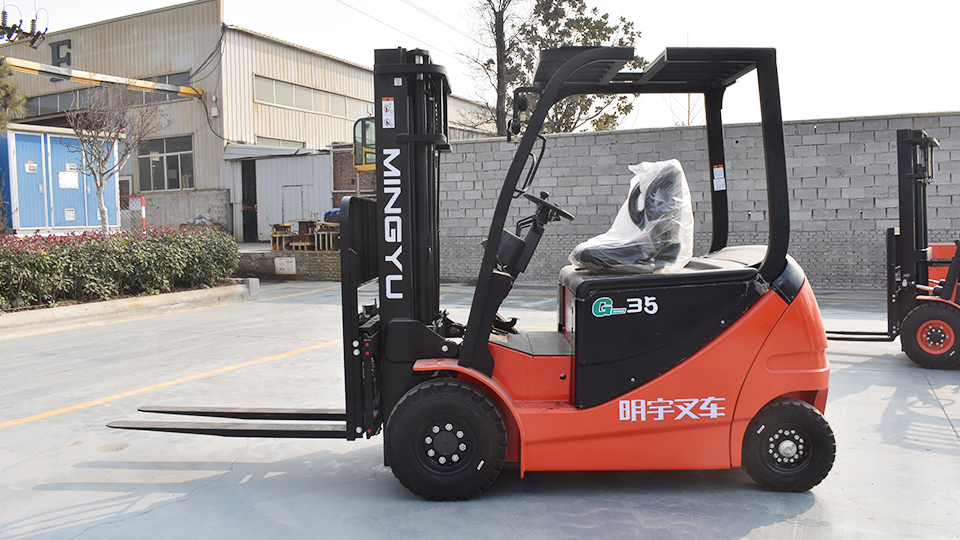
Stability Triangle: Forklift stability relies on a three-point base formed by the two front wheels and the pivot point of the rear axle. The center of gravity of the forklift and the load must remain within this stability triangle to prevent tipping.

Potential for Damage: Even if a forklift has the theoretical lifting capacity to handle the weight of a car, the risk of causing significant damage to the vehicle's undercarriage, exhaust system, fuel lines, brake lines, and other critical components with the forklift forks is extremely high.
Stability Concerns: Lifting a car, with its uneven weight distribution and high center of gravity relative to a typical palletized load, can severely compromise the forklift's stability. The risk of the forklift tipping forward or sideways is significantly increased, especially during lifting, lowering, or maneuvering.
Theoretical Capacity vs. Practical Application
While some heavy-duty forklifts might possess a rated lifting capacity that exceeds the weight of a small car, this theoretical capacity does not automatically translate to a safe or practical lifting operation. The factors mentioned above – load center, weight distribution, lack of secure lifting points – drastically reduce the effective lifting capacity and introduce unacceptable safety risks.
Consider a forklift with a rated capacity of 5,000 lbs at a 24-inch load center. A small car might weigh around 3,000 lbs. However, attempting to lift this car without proper lifting points would likely result in the load center being significantly further out than 24 inches, drastically reducing the forklift's actual lifting capacity at that configuration. Furthermore, the uneven weight distribution could place excessive stress on one side of the forks, potentially causing structural failure.
The Necessity of Specialized Lifting Equipment
The automotive industry and vehicle maintenance professionals rely on specialized lifting equipment designed specifically for the task of lifting cars safely and without damage. This equipment includes:
Automotive Lifts (Two-Post and Four-Post Lifts): These lifts are designed to engage specific, reinforced lifting points on a vehicle's chassis, providing stable and secure support for maintenance and repair work. They distribute the lifting force evenly across multiple points, minimizing stress on the vehicle's structure.
Floor Jacks and Jack Stands: These tools are used for lifting specific sections of a vehicle for tire changes or localized repairs. Jack stands provide secure support once the vehicle is raised.
Engine Hoists (Cherry Pickers): These specialized cranes are designed for lifting engines and transmissions, utilizing chains and slings attached to designated lifting points on the engine block.
Wheel Dollies: These platforms with wheels allow for the easy movement of vehicles with flat tires or those that cannot be started.
The design and operation of these specialized tools directly address the limitations and risks associated with attempting to lift a car with a forklift. They prioritize secure engagement with designated lifting points, even weight distribution, and stability throughout the lifting process.
Potential Risks and Safety Hazards
Attempting to lift a car with a forklift without proper training, equipment, and procedures is fraught with potential risks and safety hazards, including:
Damage to the Vehicle: As mentioned earlier, the concentrated force of the forklift forks on unsupported areas of the car's undercarriage can cause significant structural damage, including bending the chassis, damaging suspension components, and rupturing fluid lines.
Load Instability and Slippage: Without secure attachment points, the car is highly likely to shift or slip off the forks during lifting or transport, potentially causing severe damage to the vehicle and creating a significant crushing hazard for anyone nearby.
Forklift Tipping: The uneven weight distribution and high center of gravity of a car can easily exceed the forklift's stability limits, leading to the forklift tipping over, which can result in serious injury or even fatality for the operator and bystanders.
Falling Load: If the car slips off the forks, it can fall with tremendous force, causing severe damage to the vehicle, the forklift, and the surrounding environment, as well as posing a critical crushing hazard.
Operator Injury: Attempting such a нестандартная (non-standard) lift without proper training and equipment significantly increases the risk of operator error and injury.
Exceptional Circumstances and Specialized Attachments
While generally unsafe and not recommended, there might be extremely specific and controlled circumstances where a forklift could be used to lift a car, but only with specialized attachments and under strict protocols:
Specialized Car-Lifting Attachments: Some manufacturers offer specialized forklift attachments specifically designed for lifting vehicles. These attachments typically feature padded cradles or frames that securely engage with the car's wheels or designated lifting points, distributing the load more evenly and minimizing the risk of damage. However, even with these attachments, the forklift must have sufficient lifting capacity and stability for the specific vehicle being lifted, and the operation must be performed by highly trained personnel following detailed procedures.

Salvage Operations: In very specific salvage or recovery scenarios, where the condition of the vehicle is irrelevant and the primary goal is simply to move it, a heavy-duty forklift with appropriate rigging (chains, slings, and lifting beams) might be used. However, this would still require careful planning, experienced operators, and adherence to strict safety protocols to minimize the risk of the load shifting or the forklift becoming unstable.
Regulatory Considerations and Best Practices
Occupational safety and health regulations in most regions strongly discourage the use of forklifts for tasks they are not specifically designed for, particularly lifting objects as нестандартные as vehicles. Best practices dictate the use of appropriately designed and certified lifting equipment for specific tasks. Attempting to lift a car with a standard forklift would likely be considered a violation of safety regulations and could result in significant penalties in the event of an accident.
Conclusion: A Task Best Left to Specialized Equipment
In conclusion, while a forklift might theoretically possess the raw lifting capacity to handle the weight of a car in some limited cases, the practical and safety implications make it an overwhelmingly ill-advised and dangerous undertaking. The lack of dedicated lifting points on cars, their uneven weight distribution, the high risk of vehicle damage, and the significant potential for forklift instability render standard forklifts unsuitable for this task.
The automotive industry relies on a range of specialized lifting equipment designed specifically to handle the unique challenges of lifting and supporting vehicles safely and without damage. Attempting to circumvent these purpose-built tools with a forklift not only jeopardizes the integrity of the vehicle but also poses a severe risk of injury or fatality to personnel and damage to property. The question of whether a forklift can lift a car is ultimately overshadowed by the far more critical question of whether it should. The answer to the latter is a resounding no, emphasizing the paramount importance of using the right tool for the job and adhering to established safety protocols in all lifting operations.
Name: selena
Mobile:+86-13176910558
Tel:+86-0535-2090977
Whatsapp:8613181602336
Email:vip@mingyuforklift.com
Add:Xiaqiu Town, Laizhou, Yantai City, Shandong Province, China